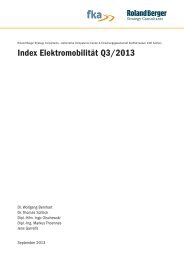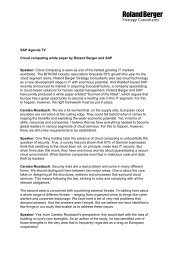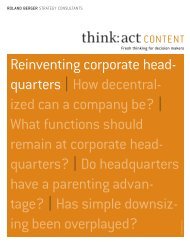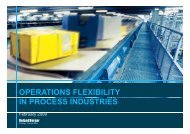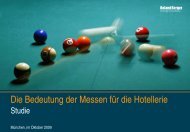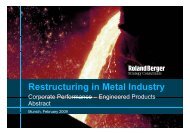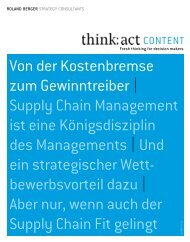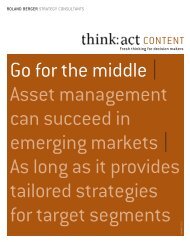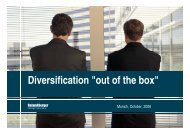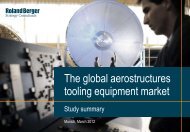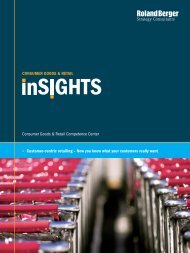Global automotive supplier study 2010 - Roland Berger
Global automotive supplier study 2010 - Roland Berger
Global automotive supplier study 2010 - Roland Berger
- No tags were found...
Create successful ePaper yourself
Turn your PDF publications into a flip-book with our unique Google optimized e-Paper software.
Revenues in the global auto <strong>supplier</strong> industry are almost back at precrisislevels – Profitability may reach an all-time high of ~6% in <strong>2010</strong>Key <strong>supplier</strong> performance indicators 2000-<strong>2010</strong>e (n = ~530 <strong>supplier</strong>s)Revenue growth [2000=100] EBIT margin 1) [%] ROCE 2) [%]102100159 ~1110.61529.8~1501468.89.18.4 8.4~67.41345.75.3 5.3 5.146 4.6 47 4.71244.15.31263.11121071.2 1.42009 positively impacted byreporting period of Japanese<strong>supplier</strong>s (ended March 31, <strong>2010</strong>)2.1 2.22000 2002200420062008<strong>2010</strong>e2000 2002200420062008<strong>2010</strong>e20002002200420062008<strong>2010</strong>e1) EBIT after restructuring items 2) EBIT after restructuring items/capital employedSource: <strong>Roland</strong> <strong>Berger</strong>/Lazard3
Main drivers of the volume recovery are ongoing growth in emergingmarkets as well as a "back to normal" product mixSupplier revenue development 2007-<strong>2010</strong>Average <strong>supplier</strong> revenues [2007=100]COMMENTS100Revenues2007~-20~80~4~2~3Crisis Revenues Growth Growth in Recoveryimpact 2009 in China India/ in NAFTAS. America~3Segmentmix~395OEM car Revenuesstock <strong>2010</strong>increase> Growth in China: Ongoingdemand growth fueled by overalleconomic development (sales+17% vs. 2009)> Growth in Brazil/India:Continued rise in demand (sales+14% vs. 2009)> Recovery in NAFTA: Fastrecovery after market collapse in2009 (sales +12% vs. 2009)> Segment mix: Gradual demandshift back to premium vehiclesdriven by fleet and corporatecustomers> Increase in vehicle stock:Refilling distribution channelsSource: <strong>Roland</strong> <strong>Berger</strong>/Lazard4
Looking back: The <strong>automotive</strong> <strong>supplier</strong> industry has undergone themost severe crisis in its historyEUR 200 bn:Cumulative decline in revenues 2008/2009 compared to pre-crisis levelEUR 75 bn:Cumulative reduction of EBIT in 2008and 2009 compared to pre-crisis levelEUR 15 bn:Restructuring costs booked in2008/2009EUR 15 bn:Total equity erosion, 2009 vs. 2007350: Number of <strong>automotive</strong> ti <strong>supplier</strong>s that twent bankrupt in the crisisBUT:Positive free cash flow in the industry in2009 due to massive counter-measuresSource: <strong>Roland</strong> <strong>Berger</strong>/Lazard5
SUPPLIER REVENUESRevenues in the global auto supply base collapsed by approx. 20%during the crisisSupplier revenue developmentAverage <strong>supplier</strong> revenues [2007=100]Loss of revenues 2009 vs. 2007 [% of all <strong>supplier</strong>s]> Overall economic downturn> Counter-effect of ~2.5 m unit salesdue to scrapping schemes~7 ~-1527100~-5> Temporary shift tolower-segment vehicles> Impact on <strong>supplier</strong>heavily dependent oncustomer portfolio~-7131410803575646Revenues2007Growthin ChinaDownturnin triadSegmentmixOEM carstockreductionRevenues2009< -50% -40% -30% -20% -10% 0% 10% 20% 30% 40% >Source: <strong>Roland</strong> <strong>Berger</strong>/Lazard6
SUPPLIER PROFITSAround EUR 75 bn in EBIT was "lost" during 2008 and 2009compared to 2007Supplier profitability 2000-2009EBIT margin 1) [%] – <strong>Global</strong> and EuropeEBIT 1) [EUR bn] – <strong>Global</strong>5.35.23.84.14.64.45.95.36.35.16.34.76.65.7~46∑ = ~-75-37 -383.13.02.0World1.21.4~9~8-1.120002001200220032004200520062007200820092007200820091) EBIT after restructuring itemsSource: <strong>Roland</strong> <strong>Berger</strong>/Lazard7
SUPPLIER PROFITSTriad <strong>supplier</strong>s suffered most – By contrast, <strong>supplier</strong>s from emergingmarkets performed extremely well, even during the crisisSupplier EBIT profitability by region 2009 vs. 2007Europe NAFTA Japan China Korea Rest of Asia WORLDChange 2009 vs.2007 [%-pts.]EBITmargin 1)[%]6.6-7.7 -3.93.2-3.8 +0.495 9.5 99 9.96.12.3 2)+1.4 +1.4 -4.311.197 9.77.25.85.71.4-1.12007 2009-0.72007 2009 2007 2009 2007 2009 2007 2009 2007 20092007 2009EBIT 1)gain/decline2008-2009 vs.2007 [EUR bn]~ -29 ~ -13 ~ -35 ~+/-0 ~ +1 ~ +1 ~ -751) EBIT after restructuring items 2) 2009 positively impacted by reporting period of Japanese <strong>supplier</strong>s (ended March 31, <strong>2010</strong>)Source: <strong>Roland</strong> <strong>Berger</strong>/Lazard8
SUPPLIER PROFITSSuppliers of tires managed to keep profitability at a reasonable leveldue to their relatively stable aftermarket businessSupplier EBIT profitability by domain 2009 vs. 2007Electric/info. Powertrain Chassis Exterior Tires Interior ALLChange 2009 vs.2007 [%-pts.]-4.9 -4.8-4.4 -3.8-3.4 -3.3 -4.3EBITmargin 1)[%]5.40.56.96.521 2.1 21 2.15.06.85.74.63.41.2 1.3 1.42007 2009 2007 2009 2007 2009 2007 2009 2007 2009 2007 2009 2007 2009EBIT 1)gain/decline2008-2009 vs.2007 [EUR bn]~ -5 ~ -25 ~ -10 ~-15 ~ -5 ~ -15 ~ -751) EBIT after restructuring itemsSource: <strong>Roland</strong> <strong>Berger</strong>/Lazard9
SUPPLIER INSOLVENCIESAs a result of the crisis, around 350 <strong>supplier</strong>s went bankrupt globallyin 2008 and 2009Insolvencies in the supply industry 2007-2009~25~45~100REGIONAL TRENDS> In the US, numerous major<strong>supplier</strong>s have been hit hard sincethe beginning of 2008 (main reason:extremely one-sided dependency onthe Detroit 3)> In Europe, the wave ofinsolvencies began in the final~552007 20082009quarter of 2008 and peaked in the~40~70middle of 2009, affecting primarily~20small and medium-sized businesses(main reason: major dependency on~25 ~25the premium segment)2007 20082009> In Japan it is particularly the very200720082009small and small <strong>supplier</strong>s that havebeen hit hard> Only a very low number ofinsolvencies have been seen innewly industrializing countriesSource: <strong>Roland</strong> <strong>Berger</strong>12
CASHFLOWBig surprise: Due to massive countermeasures, the global <strong>supplier</strong>industry achieved a positive free cash flow in 2009Supplier free cashflows 2000-2009Free cashflow 1) [% of revenues]Free cashflow 1) [EUR bn]35 3.53.12.507 0.708 0.822 2.24.224 2)> Tremendous capex cuts> Substantial net working capital reduction> Lower tax expenses> Positive impact from Japanese <strong>supplier</strong>s 3)2.4> Revenue decrease inQ4/2008> Operating costs and1.2capex still at peak level0.41832720002001200220032004200520062007200820092007200820091) EBITDA after restructuring items ./. tax ./. change in net working capital ./. capex ; investments other than capex (e.g. acquisitions) not considered2) Adjusted for net working capital increase 3) Positive impact from reporting period (ended March 31, <strong>2010</strong>)Source: <strong>Roland</strong> <strong>Berger</strong>/Lazard <strong>Global</strong> Automotive Supplier Database <strong>2010</strong>13
CASHFLOWOut of the ~EUR 75 bn decline in profitability, only one quarter hasbeen turned into a "loss" of cash compared to pre-crisis levelsComparison of EBIT vs. free cashflow decline 2008-2009 vs. 2007 [EUR bn]-191416-6213-7513EBIT 1)decline2008/09Add- back ofhigher deprecia-tion/amortization2)EBITDA 1)decline2008/09Reduction oftax expensesReduction of networking capitalReduction ofcapital expenditureFree cashflowdecline2008/091) After restructuring items 2) Not cash-relevantSource: <strong>Roland</strong> <strong>Berger</strong>/Lazard <strong>Global</strong> Automotive Supplier Database <strong>2010</strong>14
Looking ahead: The global market for <strong>automotive</strong> OE 1) componentswill grow by approx. EUR 160 bn from 2008 to 2020Major drivers for development of <strong>automotive</strong> component market [EUR bn]VOLUME PRODUCT MIX 2) PRICE∑ = ~175∑ = ~701205085658530 BRI55C25~665~505Revenuepool 2008Triad 3)BRICRoWAdditions of"winning"componentsDecline in"losing"componentsPrice reductionfor hardwareRevenuepool 20201) Original equipment 2) Includes price reductions of electronics-related content 2) Partly due to crisis recovery effectSource: <strong>Roland</strong> <strong>Berger</strong> <strong>automotive</strong> components market model15
But: the EUR 160 bn is mainly created in the powertrain domain andin the BRIC markets – Most other product segments will stagnateAdditional auto component revenue pool 2020 vs. 2008 by domain/region [EUR bn]TriadBRICOtherRoWPowertrain22.220.10.525.09.85.3Chassis1.62.40.76.23.01.9Exterior3.85.6-1.312.47.14.6Interior19 1.919 1.9-1.6 1611.063 6.337 3.7Infotainment0.50.9-1.41.10.50.5Bubble size represents the revenue pool delta 2020-2008 exceeds EUR 10 bn Shrinking marketsSource: <strong>Roland</strong> <strong>Berger</strong> <strong>automotive</strong> components market model16
Some more bad news for <strong>supplier</strong>s will come from the general<strong>automotive</strong> industry environmentTrends shaping the <strong>supplier</strong> industry in the futureCar buyersOEMsSUPPLIERSRaw material markets1Regional shiftPi Price sensitivityReduced price levelLegislation2CO 2 reductionEmission reductionSafety regulations3Additional cost savingmeasuresLocalization ofproduction (to salesmarkets)Overcapacity/restructuring (triad)Increased technologicalcomplexityFurtherincreasedmargin pressureand risingcapital needs4Provider consolidationRising i demand d(from other industries)Increasing pricesCapital markets5Liquidity shortages(equity and debt)Loss of confidenceof investorsAdditional costIncreased pressureIncreasing capital costs= increased importance over the past two yearsSource: <strong>Roland</strong> <strong>Berger</strong>/Lazard17
3 OEMSAfter some concessions during the crisis, OEMs have dramaticallyincreased pressure on their <strong>supplier</strong>s againExamples of selected recent OEM requests made to <strong>supplier</strong>s (not representative)OEMs"Pay to play": request for immediate reduction of prices by up to 10% on entire existingbusiness (despite contracted higher price levels) to avoid being "blacklisted" for <strong>2010</strong>Verbally agreed contracts are awarded to competitorOutstanding and approved invoices are simply not being paidSignificant ifi extension of warranty periods within existing i contracts, e.g. from 24 to 36monthsExpenses for R&D services or for investments taken by the <strong>supplier</strong> are not beingreimbursed despite different (earlier) agreementsPayments are being delayed by not confirming that pre-agreed quality gates in joint R&Dprojects have been met (even though parts are already in series production)Elements of running contracts are simply being changed by the OEMs (in favor of theOEM), e.g. calculation of raw material cost compensationSUPPLIERSSource: <strong>Roland</strong> <strong>Berger</strong>/Lazard18
3 OEMSOEMs' dilemma: From an individual perspective, they have to squeeze<strong>supplier</strong>s – But this also creates the "problems of tomorrow"OEMs' dilemma<strong>Global</strong>overcapacityOEM pressureon <strong>supplier</strong>sSuppliersUnhealthyh OEMs don'tfight for their industrycure the unhealthysurvivalstructures structures> Car markets arebuyers' markets> Strong and furtherincreasing consumerprice pressure> In a highly competitiveenvironment,profitability of theindividual OEMs mustbe the key ypriority> OEMs need to avoidcreating positiveexternal effects forother OEMs via "tooattractive pricing" for<strong>supplier</strong>s> Only limitation:potential quality anddelivery problems> Most <strong>supplier</strong>s try todefend theirbusiness via veryaggressive pricing> Shutting downplants or reducingcapacity is mostlynot considered as areal option (alsogiven the high exitcosts)> Many productsegments have astructurally low profitmargin (especiallyprocess-focusedsegments)> These segments aremostly alsocharacterized by highfragmentation – andan above-averagenumber of <strong>supplier</strong>sare in poor shape> Legal issues (anti-trust)prevent OEMs from drivingactive consolidation> OEMs don't want to create"reference cases" forother weak <strong>supplier</strong>s byresolving critical situations> OEMs have very differentexposure and objectivesin specific segments> OEMs don't want to injecttheir own cash into the<strong>supplier</strong> businessSource: <strong>Roland</strong> <strong>Berger</strong>/Lazard19
As a consequence of these trends, we expect <strong>supplier</strong> profitability todecline and capex to increase after <strong>2010</strong>Profitability and investment requirements of the <strong>supplier</strong> industry in the futureEBIT margin 1) [%]Investment requirements <strong>2010</strong>-2015 [% of revenues]5.7~6 64 6.45.6~4-5In addition: HigherR&D expenses4.46-6.51.21.42007 2008 2009 <strong>2010</strong> 2011-15e2007 2008 2009 <strong>2010</strong>-2015e1) EBIT after restructuring itemsSource: <strong>Roland</strong> <strong>Berger</strong>/Lazard20
The situation will become particularly challenging for a large groupof structural underperformers, which represent ~20% of the industrySupplier assessment 2009 based on performance and stability [% of all <strong>supplier</strong>s]PERFORM MANCEAboveaverageAverage10%8%9%5%TOP performer19%8%PERFORMANCE> Revenue growth 2000-2009 vs. industryaverage [2.6%]> Average ROCE 2000-2009 vs. industryaverage [7.2%]> ROCE 2009 vs. industry average [2.2%]LOW performerSTABILITYBelowaverage19%Belowaverage11%Average11%AboveaverageSTABILITY> Leverage 2009 vs. industry average [1.6x]> Equity ratio 2009 vs. industry average[36.7%]Source: <strong>Roland</strong> <strong>Berger</strong>/Lazard21
Most of the process-focused segments are still far too fragmented,resulting in overcapacity and price warsCompetitor structure in selected process-based segments [market share, %]#1#2#3#4#5Other12%4%3% 3%75%3%11%9%9%8%8%13%11%9%4% 8%12%11%8%8%8%55% 55% 53%16%12%10%10%9%16%14%12%10%7%16%14%14%9%9%43% 41% 38%20%18%13%12%8%29%50% of theglobalmarketAluminumalloy castingsCast-ironcyl. blocksFriction discsCold formingNVH1)Pipe systems2)Sealingcomponents 2)Acoustics/insulation1) Noise, vibration, harshness 2) European market shareSource: <strong>Roland</strong> <strong>Berger</strong>22
Suppliers and OEMs need to switch to a more collaborativeapproach in order to solve the structural problems of the industryNeed for actionSUPPLIERS' NEED FOR ACTIONOEMS' NEED FOR ACTION> Further improve operational efficiency> Establish strategic partnershipsalong the entire value chainwith selected <strong>supplier</strong>s> Increase discipline on pricing side andrefuse unprofitable business> Select growth opportunities (regions,products) very carefully> Look for additional sources of financing> Collectively reduce pressuretowards supply base (e.g. "pay toplay")> Actively support consolidationprocess, especially in unhealthy(process- focused) segmentsSource: <strong>Roland</strong> <strong>Berger</strong>/Lazard23



